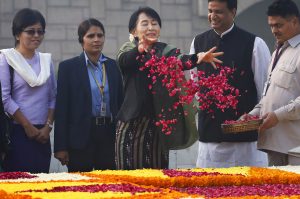India’s Foreign Secretary Harsh Vardhan Shringla along with country’s army chief General M.M. Naravane is visiting Myanmar on October 4 and 5. Shringla and Naravane will meet with State Counsellor Aung San Suu Kyi and Senior General Min Aung Hlaing, the commander-in-chief of Myanmar’s powerful army. Last week, on October 1, India and Myanmar held the 19th round of Foreign Office Consultations virtually, with the Indian side led by Shringla and Myanmar’s by Permanent Secretary U Soe Han.
The visit takes place amid growing disarray in India’s relations with many of its land neighbors, and China’s political and economic thrust in India’s sphere of influence. The fact that the Indian army chief is accompanying Shringla suggests that the India-Myanmar talks will also focus on the restive land border between the two countries. Myanmar’s territory has been used in the past as a staging ground for rebel attacks on Indian security forces.
Despite a rhetorical “Neighborhood First” commitment, the Narendra Modi government has floundered when it comes to maintaining primacy there, as India’s domestic politics and capabilities constraints as well as China’s growing regional economic clout threaten to weaken New Delhi’s traditional upper hand in the relationships with Nepal and Bangladesh. When it comes to Myanmar, its importance for India is obvious, as a natural bridge into Southeast Asia.
As the South Asian Association for Regional Cooperation (SAARC) – which does not include Myanmar – remains moribund, and India attempts to play a more robust role to the country’s east – whether that is through deeper engagement with the Association of Southeast Asian Nations (ASEAN) or promotion of groupings such as Bay of Bengal Initiative for Multi-Sectoral Technical and Economic Cooperation (BIMSTEC) – New Delhi has sought to engage Naypyidaw closely and pragmatically.
Realism has dictated India’s Myanmar policy. New Delhi, for example, engaged Myanmar’s military junta even as the country’s pro-democracy movement strengthened. More recently, country’s stance on the Rohingya issue has been calibrated while keeping the Myanmar leadership in mind, resulting in India being criticized by some for its apparent nonchalance when it comes to human rights abuses. As Bangladesh-Myanmar relations inch toward the brink, New Delhi has sought to engage Dhaka and Naypyidaw individually, walking a tightrope between the two. In August Shringla rushed to Bangladesh, soon after news emerged that China will advance a $1 billion loan to that country to manage and restore the Teesta river.
In the past, Rohingya refugees in India have crossed over to Bangladesh in order to avoid deportation to Myanmar. Both India and Bangladesh support repatriation of the Rohingyas to Myanmar even though subtle differences in their stance on the issue remain.
Chinese President Xi Jinping’s Myanmar visit in January – and an attendant push for a China-Myanmar Economic Corridor – left many in India rattled. On its part, New Delhi’s perennial delivery-commitment mismatch means that ambitious projects it has promoted in the past remain incomplete. A 1,360-kilometer long India-Myanmar-Thailand trilateral highway project, under which India would have constructed 69 bridges in Myanmar along with a road section, remains mired in a legal dispute in India between the government and a private contractor. Noting the adverse strategic implications of this dispute in August, India’s Attorney General K.K. Venugopal told the country’s Supreme Court: “We have received a letter from our ambassador in Myanmar saying that China completes its projects swiftly and on time but India’s credibility is under question.”
This is just the latest instance of how India sputters when it comes to delivering on its infrastructure promises in Myanmar. For example, the 2008-launched Kaladan Multi-modal Transit Transport Project (KMTTP), which would have linked India’s Calcutta port to Sittwe in Myanmar, as well as facilitated land connectivity, was scheduled to be completed by 2016.. Four years later, the end is not in sight. Earlier, on October 1, Shringla noted that India and Myanmar “are working towards operationalizing the Sittwe Port by the first quarter of next year.” During Shringla’s ongoing visit, India and Myanmar are scheduled to sign a shipping agreement to support the KMTTP.
However, India-Myanmar relations are as much about India’s immediate national security concerns as they are about geoeconomics and geopolitics. Myanmar’s military, the Tatmadaw, has a track record of cracking down on anti-India armed groups operating out of its soil to advance their insurgency in India’s northeast — or even allowing India to do so itself. In June 2015, an Indian special forces operation targeted Naga rebel camps across the India-Myanmar border, an avowed operation widely seen as the precursor to the “surgical strikes” in Pakistan-administered Kashmir the following year. As the latest round of talks between the Indian government and Naga insurgents continue, New Delhi will almost certainly look to the Myanmar army for continued support to flush out or eliminate elements that may not be in favor of a settlement, should it indeed materialize. The 2015 cross-border special forces action targeted a camp of the National Socialist Council of Nagaland (K) Naga rebel group, along with one of the Kanglei Yawol Kanna Lup (KYKL); the NSCN (K) is not a party to the ongoing Indo-Naga negotiations. Reports have also suggested that the NSCN (IM) group – which is negotiating with the Indian government – has moved some weapons and cadre across the border, into Myanmar.
Last year, the Tatmadaw cracked down on the anti-talk United Liberation Front of Asom faction in their country, leading to 15 members of the group surrendering to the Indian government. Counterterrorism cooperation will feature in the agenda of the Shringla-Naravane visit, sources have told the Hindustan Times.
India and Myanmar signed a defense cooperation agreement in July last year.

































